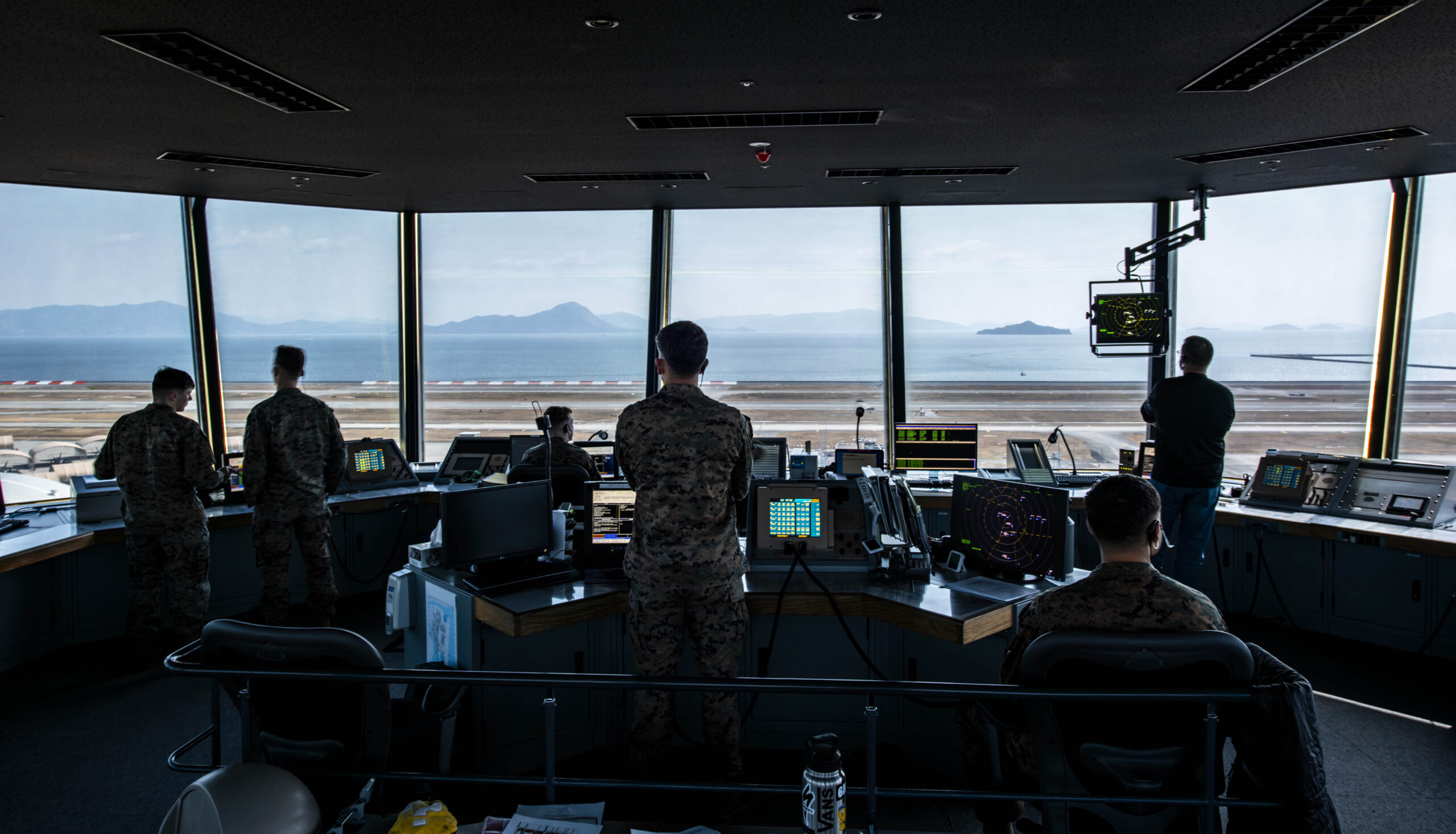
Safeguarding the Airspace: Marine Air Traffic Controllers’ Critical Role in Marine Aviation
By: Kyle WattsPosted on April 15, 2024
Marine Air Traffic Controllers (ATCs) represent a small slice of the active-duty component. Less than 1,000 of these Marines exist in the service today, with even fewer operating in capacities actually controlling aircraft. Though small in number, these Marines perform a vital “behind the scenes” function for Marine aviation, providing safety and order within their assigned airspace.
The path to achieving the Marine ATC designation 7257 looks different from other MOS training pipelines. Following boot camp and Marine Combat Training, prospective ATCs attend entry-level training at Naval Air Station (NAS) Pensacola, Fla. Marine and U.S. Navy instructors teach students the fundamentals of air traffic control, tower and radar operations, and provide them with a baseline understanding of Navy and Marine Corps policies and Federal Aviation Administration (FAA) regulations. Graduates depart less than six months later as 7251 Air Traffic Control trainees. Each trainee receives an assignment to one of the 10 permanent Marine Corps ATC Facilities around the world, where the training continues.
A controller’s credentials vary depending on the facility to which they are assigned. In order to control aircraft inside the assigned airspace, new trainees must complete certifications within an allotted timeframe from the day they check in. This process can take over a year in some cases. Because of this extensive training, ATC candidates enlist for an initial period of five years, rather than the standard four-year contract. During their training period, Marines are cleared to operate from the tower, communicating with aircraft actively landing or departing the runway, and the radar room, keeping an eye on the entire airspace and communicating with incoming aircraft beyond visual range.
In a world where specific credentials are required to hold increasing levels of responsibility, Marine Corps rank structure matters little in deciding who performs what duties. Lance corporals on their first enlistment might act as tower supervisors, watching over corporals as they talk with aircraft and instruct sergeants or staff sergeants who just checked in. This practice is largely unique to the ATC field. Every duty station requires its own set of credentials to understand the specific airspace and the types of aircraft it accommodates. As a result, moving to a new location at any rank can be like starting over again. Career Marines can easily spend three or four years away from their craft on a special duty assignment such as recruiting, drill instructor or Marine Security Guard. Loss of currency, coupled with the requirement to obtain credentials upon return to the community, can be a daunting task.
At the Marine Corps Air Facility in Quantico, Va., roughly 40 Marines control the airspace in shifts around the clock. Corporal Abraham Gamboa serves as one of the tower supervisors.
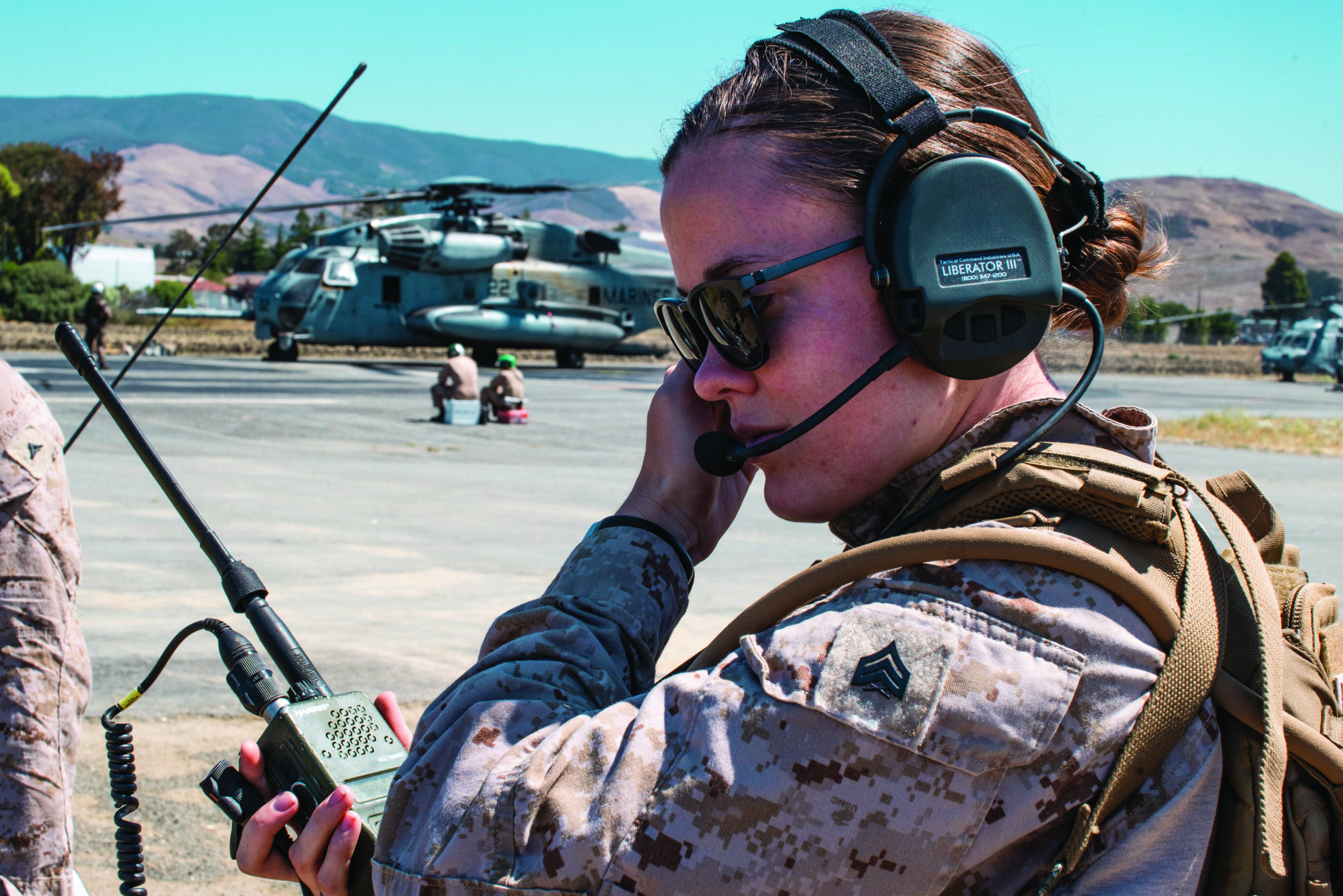
“Painting the picture for the pilots will solve all the problems,” Gamboa said, breaking down the essence of his job in its simplest terms.
Tower-related aircraft mishaps typically result due to a lack of communication between controllers and pilots. It is the responsibility of the ATCs, Gamboa explained, to inform the pilots of anything that might inhibit their safe landing or departure. During a Leatherneck visit to the tower at Quantico, Gamboa demonstrated this tenant of air traffic control with a sophisticated simulator. All kinds of variables can be entered to throw off the ATCs. While another Marine demonstrated how he would bring in a simulated plane, Gamboa manipulated helicopters circling, weather patterns changing, flocks of birds swarming, and even a herd of deer sprinting across the runway.
“We sequence, we separate, and we make sure everyone abides by the rules to remain safe within the airspace,” explained Staff Sergeant Marcus Beacham, ATC Training Chief at MCAF Quantico.
Controllers assigned to USMC air stations and facilities, like the Marines at Quantico, are also somewhat unique because they are non-deployable. They serve as permanent staff members of each Marine Corps installation. To deploy, controllers must achieve their 7257 designation and be assigned to an Air Traffic Control Company. These units fall under the Marine Air Control Groups of their respective Marine Aircraft Wing. Marines train for deployment in scalable units, from single Marines deploying as liaisons to allied airfields around the world, to a full company deployment into a combat zone. The capabilities they offer scale in relation to the size of the unit going forward and the gear they carry. This quality of Marine ATCs makes them the only branch of service with ATCs trained and equipped to provide expeditionary Instrument Flight Rules (IFR) services.
Marine ATCs have accompanied aviators in combat since WW II. The first of these Marines served with the Marine Air Warning Group established in 1943, focusing their radar capabilities on providing early warning and fighter direction. Post-war changes upgraded and reformed the group into Marine Air Traffic Control Units (MATCUs). By the Vietnam War, MATCUs offered a full complement of all-weather capabilities.
A small detachment from MATCU-62 served admirably in one of the most high stress and high visibility settings of the war. Led by Captain William J. Flahive Jr., the section of controllers and radar operators arrived at Khe Sanh in February 1967. The North Vietnamese Army shut down all road traffic to the base by the fall of that year. Defenders depended on aerial resupply to keep them in the fight. The ATC detachment faced difficulties of every variety in their effort to orchestrate a continuous flow through the airstrip. A deep gorge just beyond the end of the runway threatened to swallow any aircraft that ventured beyond the tarmac. Thick fog often formed in the warm air, making it difficult for pilots to locate the base in the mountainous terrain. The enemy, however, presented the most deadly and consistent obstacle to overcome.
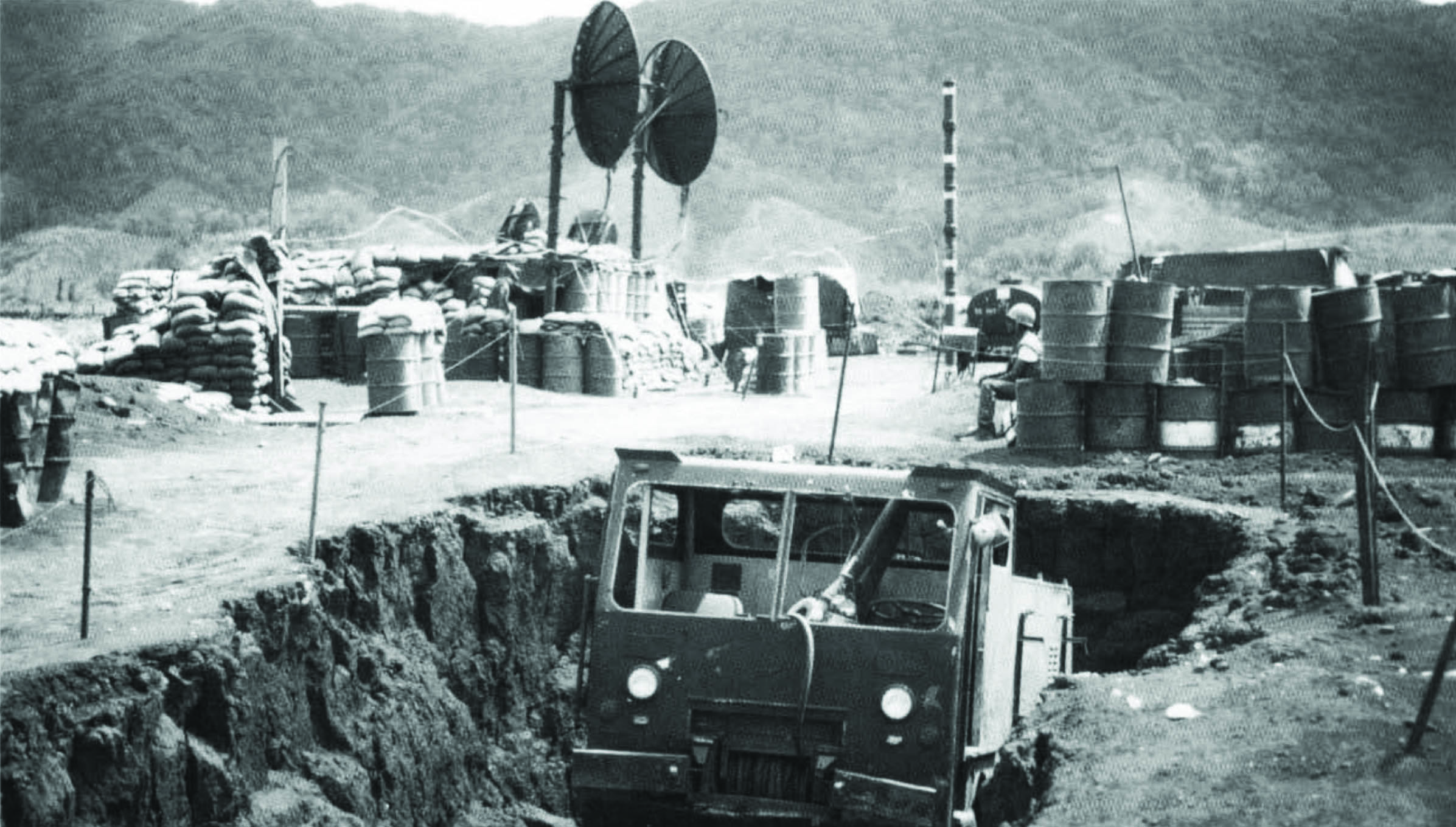
North Vietnamese antiaircraft and indirect fire kept the Marines under constant attack. The ATCs performed their duties regardless. On Jan. 31, 1968, NVA artillery and rockets struck the airstrip, killing Capt Flahive and wounding other Marines of the detachment. More enemy rockets destroyed the primary ground approach control radar a few weeks later. The Marines adapted another radar system, typically employed for bombing missions, to take over this vital task.
As the demand for supplies increased, and enemy fire limited the availability of of the runway, the ATCs played a critically important role coordinating with aircraft to drop supply crates under parachute. They worked directly with pilots, communicating compass headings and wind conditions in order to precisely time each drop into the designated zone. At the prescribed release point, pilots nosed up and applied full power, forcing pallets of supplies to roll backward out the open cargo door. By the end of the siege at Khe Sanh, the MATCU-62 detachment coordinated nearly 500 container drops, equaling roughly 8,000 tons of supplies.
Marine Air Traffic Control evolved further after Vietnam. By the beginning of the global war on terror, a new deployable team of ATCs existed within the Marines’ organization; the Marine Mobile Air Traffic Control Team, or MMT. MMTs operate today as the smallest scaleable unit capable of providing air traffic control services. A textbook MMT is composed of six Marines; one team leader, three ATCs, and two equipment maintainers. In Iraq and Afghanistan, MMTs worked in conjunction with IFR Detachments, today the equivalent of a full Air Traffic Control Company.
Lieutenant Colonel Benjamin Kiley, currently serving as the Commanding Officer of Marine Air Control Squadron 1 out of Yuma, Ariz., remains one of the few Marine officers still on active duty that deployed to Iraq or Afghanistan with a full IFR Detachment under his command.
“Marine air traffic control is what makes the Marine Corps an all-weather aviation force,” Kiley said. “For a flying squadron to be all-weather and instrument rated, that means somebody has to be on the other side of the microphone with radar capabilities providing you with instrument flight rules air traffic control services. If you go back to OIF or OEF, IFR Detachments were out there with the ability to provide full radar services and precision recovery.”
Two IFR Dets deployed to Iraq, and one to Afghanistan. These units, nearly 150 Marines strong, provided the crucial capability for Marine aviators to fly 24/7 and beyond visual range. Numerous MMTs moved further out from the main air bases providing ATC services on the front lines. The equipment they carried limited their services to visual range. From January to August 2008, Kiley served as the IFR Det Commander at Al Taqaddum Air Base in Habbaniyah, Iraq. U.S. Navy ATCs augmented the Marines as the detachment became overtasked with air traffic control requirements to support the war. Four MMTs under Kiley’s command went forward from Al Taqaddum to provide ATC services in Fallujah, Ramadi, Mudaisis and Rawah. Controllers in these locations routinely endured enemy fire while performing their duties.
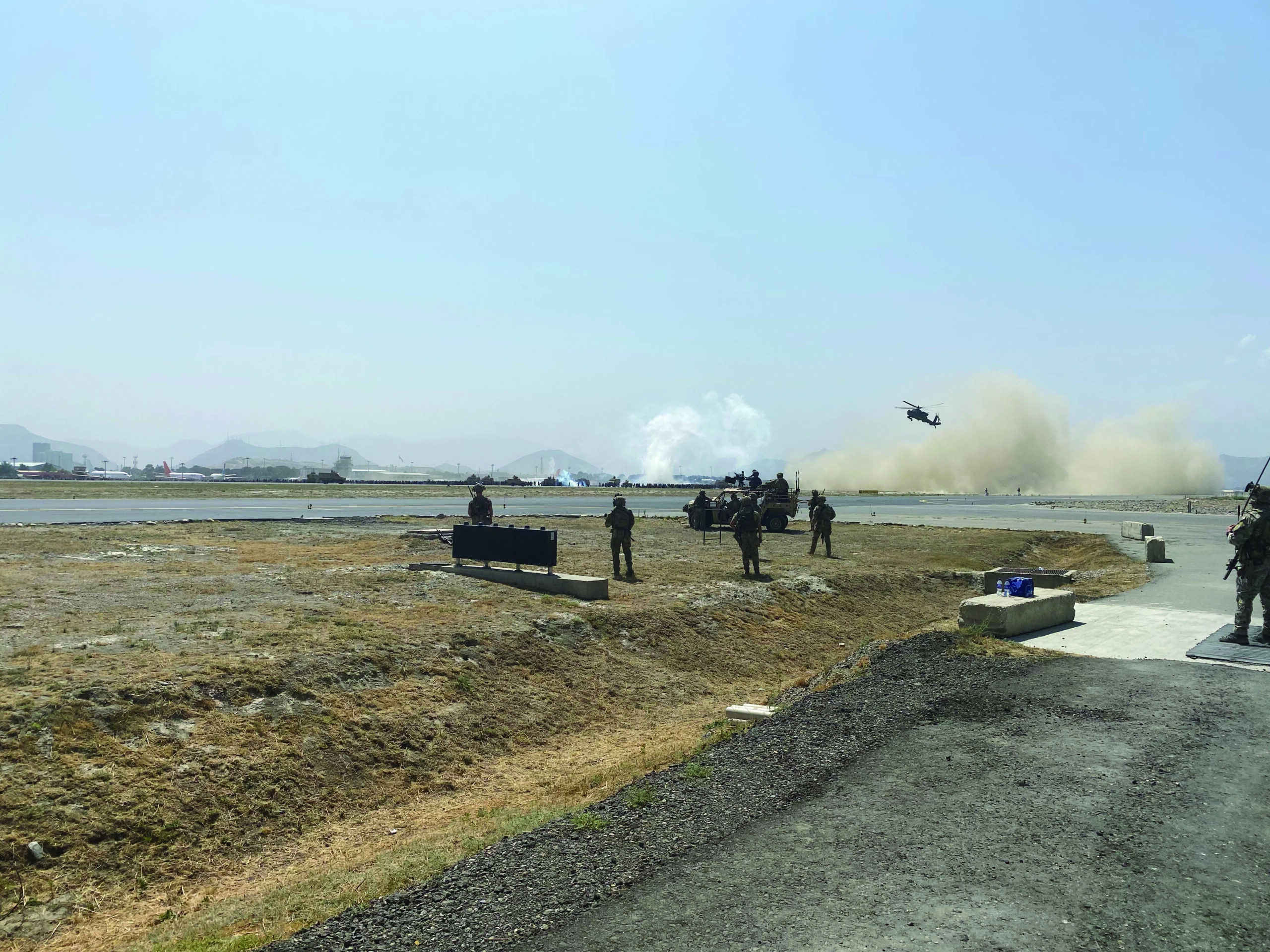
“We’ve always been a hot spot for the pot shot,” Kiley reflected. “You can’t put a tower on top of a building and not expect your adversary to shoot at it.”
In one example, Kiley described the conditions faced by the MMTs stationed in Ramadi at Camp Blue Diamond. “The Marines who manned that tower would peek over a wall just to be able to control aircraft in and out.”
While serving as the Ramadi MMT leader from January to August 2007, Kiley explained the creativity the Marines used in tower construction. “We took previously destroyed humvees and removed their up-armor and put it in the walls of the towers we built. We used their ballistic glass windows as the windows for the tower. The early days of just covering your position with cammie netting were gone. We had to adapt, overcome, and harden those towers with whatever we could get our hands on to make it a little bit safer for the Marines.”
Marine ATCs remained in Iraq and Afghanistan until the very end of Marines’ involvement. They supported the withdrawal from Iraq during 2010 and 2011, and again from Afghanistan in 2014. In Iraq, during Operation New Dawn, Kiley partnered with U.S. Air Force personnel and the Iraqi government to develop the Iraqi Civil Aviation Authority, their version of the FAA, and design their airspace so that Iraq could take over management from the Marines and Air Force.
Outside of combat, the skills of Marine ATCs have been showcased time and time again through disaster scenarios and aircraft emergencies. Corporal Justin McDaniel earned a Navy and Marine Corps Achievement Medal in December 2015 after an AV-8B Harrier pilot declared a state of emergency while coming into Marine Corps Air Station (MCAS) Cherry Point, N.C. When his navigation system suddenly died, the pilot was unable to locate the airfield through the darkness and inclement weather. Seated at his radar station, McDaniel calmly communicated with the pilot, guiding him to the runway for a safe and successful landing.
In 2013, Marines deployed to the Philippines in support of Operation Damayan following a catastrophic typhoon. Marine ATCs scaled an exterior stairwell to the top of a damaged air traffic control tower in Tacloban to coordinate the arrival of disaster relief supplies. The typhoon blew out every window in the tower, leaving the Marines exposed to the elements and noise of the flight line and the surrounding devastation. The storm destroyed part of the only available runway, leaving extremely limited space for aircraft to land, park, and offload supplies. The Marines worked tirelessly alongside volunteer civilian controllers to maintain safe separation in the sky as planes waited to land, and the efficient arrival, unloading, and take off of planes on the ground.
Marines performed similarly during a stateside natural disaster in 2017. That September, the category 5 hurricane Irma pummeled the Caribbean before making its way up Florida’s Gulf Coast. Just two weeks later, another Category 5 storm named Maria struck the Caribbean before swinging wide of Florida’s Atlantic coast and proceeding out to sea. U.S. Navy personnel evacuated Naval Air Station Key West. In their stead, Marines deployed into the disaster zone to keep the airfield running and ensure the arrival of relief supplies.
“We took over NAS Key West as the air traffic control authority,” remembered Master Sergeant Kevin Haunschild, leader of the Defense Support Civil Authority Detachment from the 26th MEU, deployed to Florida for humanitarian relief operations. “There was only one Navy controller that remained behind when we showed up, so myself and the team that I took down there ended up taking over the airport with a couple of handheld radios out of the back of a F-350.”
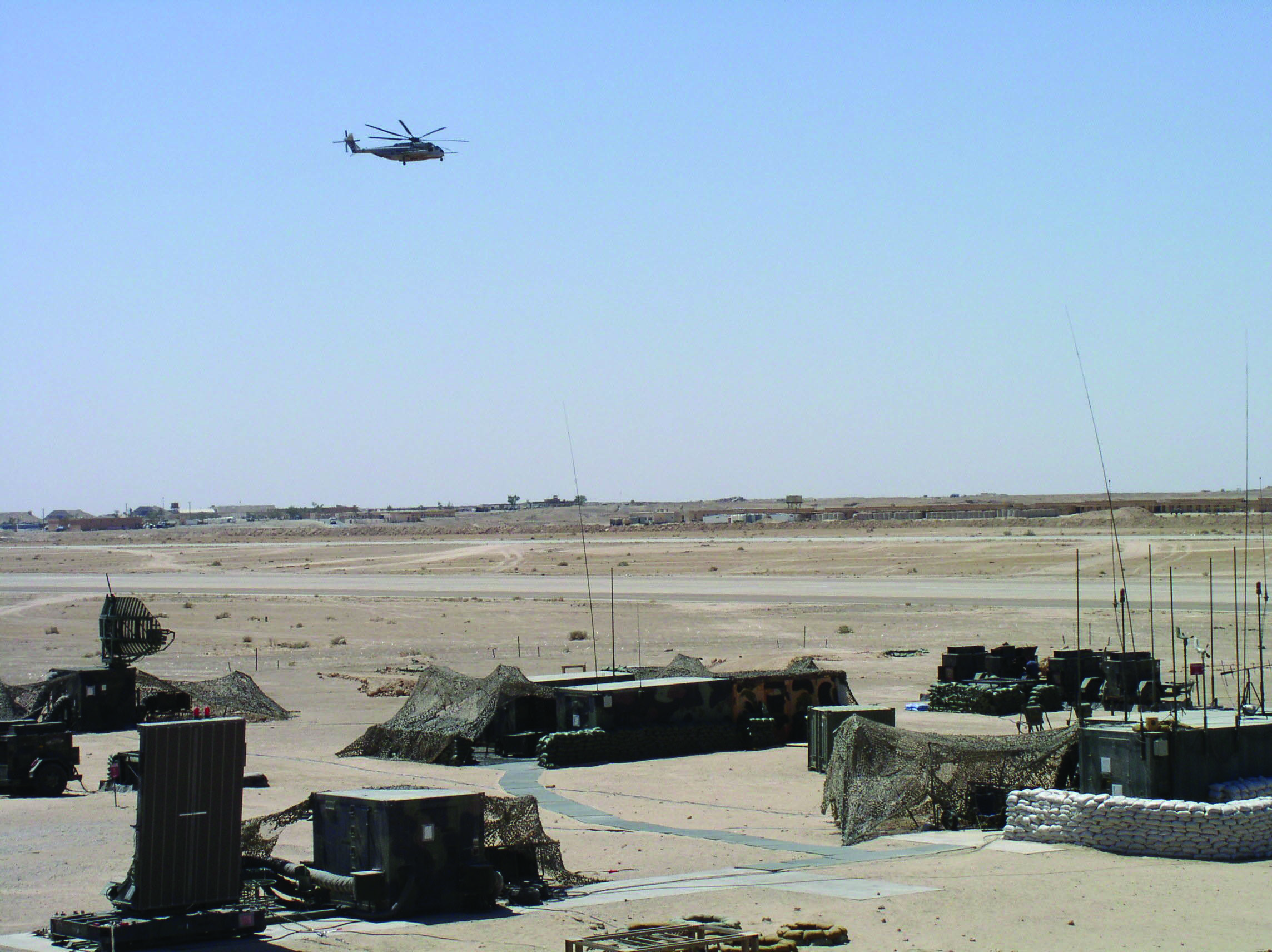
The conditions Haunschild and his team faced in Florida would pale in comparison to the obstacles that he and the MMT from the 24th Marine Expeditionary Unit (MEU) endured several years later, performing their duties through another humanitarian crisis with the eyes of the world watching.
On Aug. 13, 2021, Haunschild and Gunnery Sergeant Julio JoseMendez, the 24th MEU MMT leader, arrived at Hamid Karzai International Airport in Kabul, Afghanistan. The airport was calm and operating under normal conditions, despite the deteriorating situation outside the gates. Everything changed less than 48 hours later. As the Taliban overran the city, the civilian Department of Defense employees controlling Kabul tower were ordered to evacuate. The 24th MEU MMT remained the only air traffic controllers on the ground able to take their place.
“We were at a meeting with the colonel when the civilians were ordered to leave,” remembered JoseMendez. “The colonel turned to MSgt Haunschild and said, ‘the controllers evacuated the tower. How long until you can get your team up?’ Master Sergeant looked at him and said, ‘Fifteen minutes.’”
Haunschild and JoseMendez arrived in Kabul as part of the MEU’s advanced party. The rest of the MMT remained aboard a U.S. Navy ship. They took a pair of handheld radios and set up on the ground near the taxiway. The new “Kabul tower” location proved safer than the actual control tower due to the increasing security threat. They worked with U.S. Air Force Special Operations Combat Controllers to connect with pilots and let them know an air traffic control authority had returned. The Marines sat on the ground or stood as they controlled aircraft, exposed to the baking sun, noise of planes taxiing on the runway, and rotor wash of helicopters constantly flying low overhead. At some point, an airman brought out a cheap pop-up canopy and couple of commandeered office chairs to upgrade their new home.
“Typically, an MMT is only sustainable for 72 hours,” Haunschild said. “We were able to do it for 17 days. We didn’t do it with much, but we did it.”
On Aug. 15, Haunschild was on shift working the radio when, across the flight line, civilians started pouring over the airport’s outer wall. Hundreds became thousands. A crowd converged on the runway preventing air operations. Haunschild left the tent at Kabul tower and joined the Marines of “Alpha” Company, 1st Battalion, 8th Marines, as they attempted to push the crowd off the runway. A C-17 taxied through the mass of people. Prior to the now-infamous video of the plane lifting off with civilians clinging to the outside, Haunschild walked alongside the aircraft removing civilians as they held on for the ride. Everyone watched in shock as the plane departed and people fell from the sky.
“At that point, we weren’t in a position to control any aircraft,” Haunschild reflected. “We were in fight or flight mode. We were trying to do crowd control, and it just wasn’t working. Those first four days were the most chaotic and, unfortunately, the most memorable. You just really can’t explain it.”
By the evening of Aug. 16, the crowd retreated from the runway. GySgt Jose Mendez put on his headset and keyed up once again.
“I wanted to let everybody who was still flying know that there was an air traffic control authority still on the ground,” he said. “We were going to prop back up the control functions and enforce some form of procedures to make the pilots feel safer and know this was not yet the wild west.”
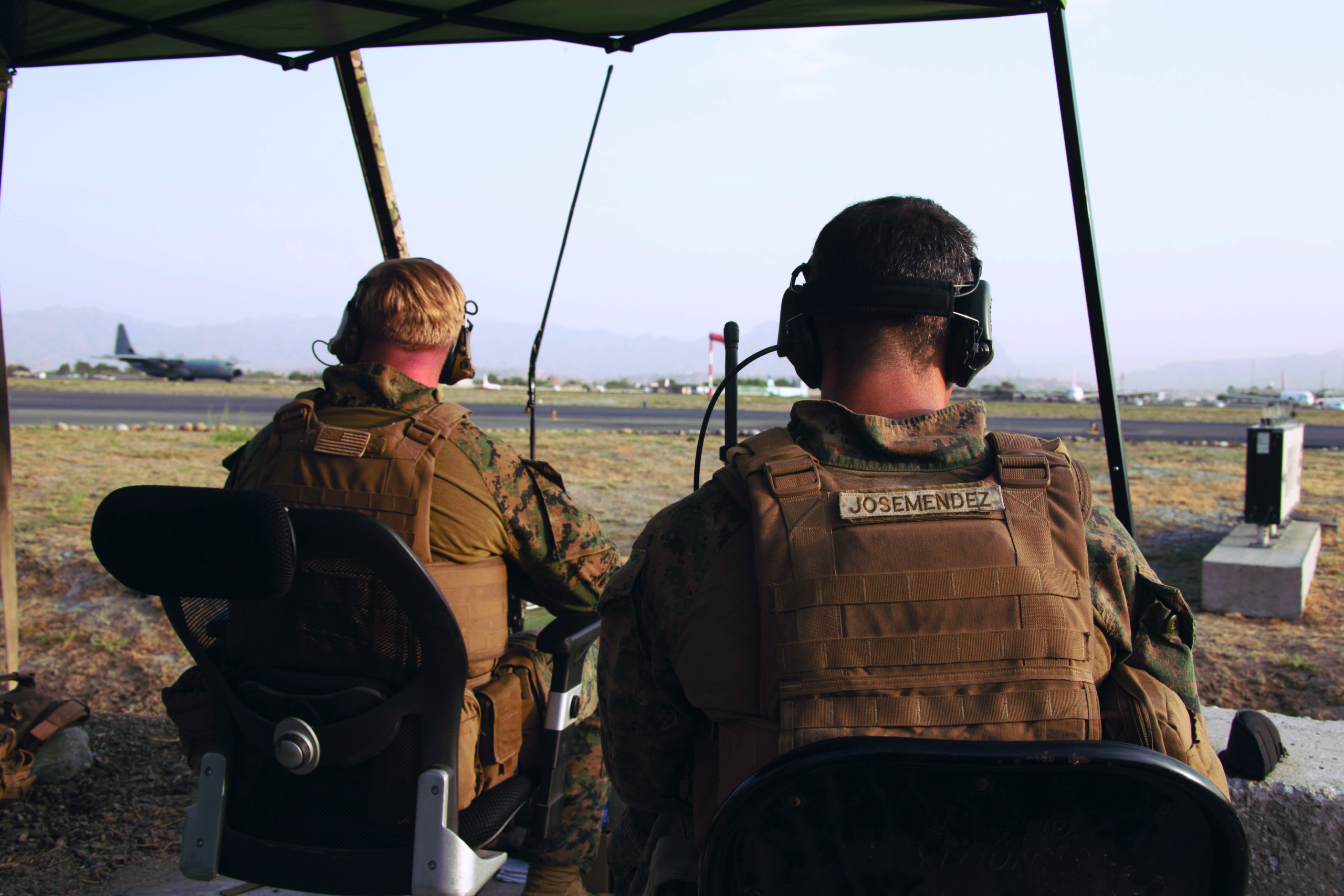
The rest of the MMT arrived the following day. With Sergeant Ian Chryst, another Marine ATC, now on deck, the team paired each Marine with a USAF controller in three shifts operating around the clock. The tempo increased as more and more civilians processed through for evacuation and loaded onto waiting aircraft. Traffic flowed constantly through the single available runway. The Marines coordinated an average of 110 aircraft per day, nearly five coming or going per hour around the clock. Stateside rules and procedures went out the window as the Marines did what they had to do bringing in aircraft of all types and sizes, one right after another in whatever order they arrived.
At one point during the evacuation, as the situation devolved into chaos, a small Afghan Air Force plane landed without clearance and stopped on the runway. The pilot and crew inexplicably abandoned the aircraft and disappeared into a nearby hangar. Was the plane left as a vehicle-borne improvised explosive device to sabotage the airfield? The Marines knew it had to be moved and no one else was going to move it. Aircraft stacked up overhead waiting to land. Haunschild, JoseMendez, and two Special Forces operators drove a pickup truck onto the runway and inspected the plane. They determined it was not rigged to detonate and towed it out of the way to resume operations.
Personnel on the ground presented one of the greatest threats to the flow of aircraft. At any given time, a vehicle or group of people on foot might cross the runway, leaving the ATCs scrambling to call off an incoming or outgoing plane. At one point, a bus full of people crossed the runway directly in front of a jet barreling down the runway for takeoff. The ATCs stood in shock as the plane creeped off the runway and missed the bus by less than 20 feet. Miraculously, throughout the evacuation, zero aircraft mishaps occurred.
Operations continued uninterrupted until Aug. 26. That afternoon, Haunschild and Chryst manned the radios at Kabul tower when the explosion at Abbey Gate detonated across the airfield directly in front of them. They immediately understood what had happened.
“We ceased all air operations for two to three hours as vehicles started coming across the runway with casualties,” Haunschild remembered. “We cleared the airport so they could get over to the medical facility. After that two to three hours, we started landing C-17s at the cyclic rate, strictly to get casualties out.”
The MMT remained at Kabul tower until the very end of the evacuation, finally leaving on the evening of Aug. 30 in one of the last American planes to depart. They handed control over to the Air Force Combat Controllers with whom they had partnered throughout the evacuation. Little remained to be done as the final few aircraft prepared to leave. Despite the myriad of obstacles, primitive conditions, lack of supplies, and skeleton set of equipment, the Marines accomplished a critical mission under the microscope of the world, one they didn’t even know would be their task until they arrived on the ground and took the initiative to get the job done.
“It’s what Marines do,” said GySgt JoseMendez. “Sometimes, you have to do more with less. Sometimes, you’re going to be put in a position where it’s not a specifically fine-tuned and planned situation. It’s a crisis, and no matter what your cards are, you have to play them to the best of your ability.”
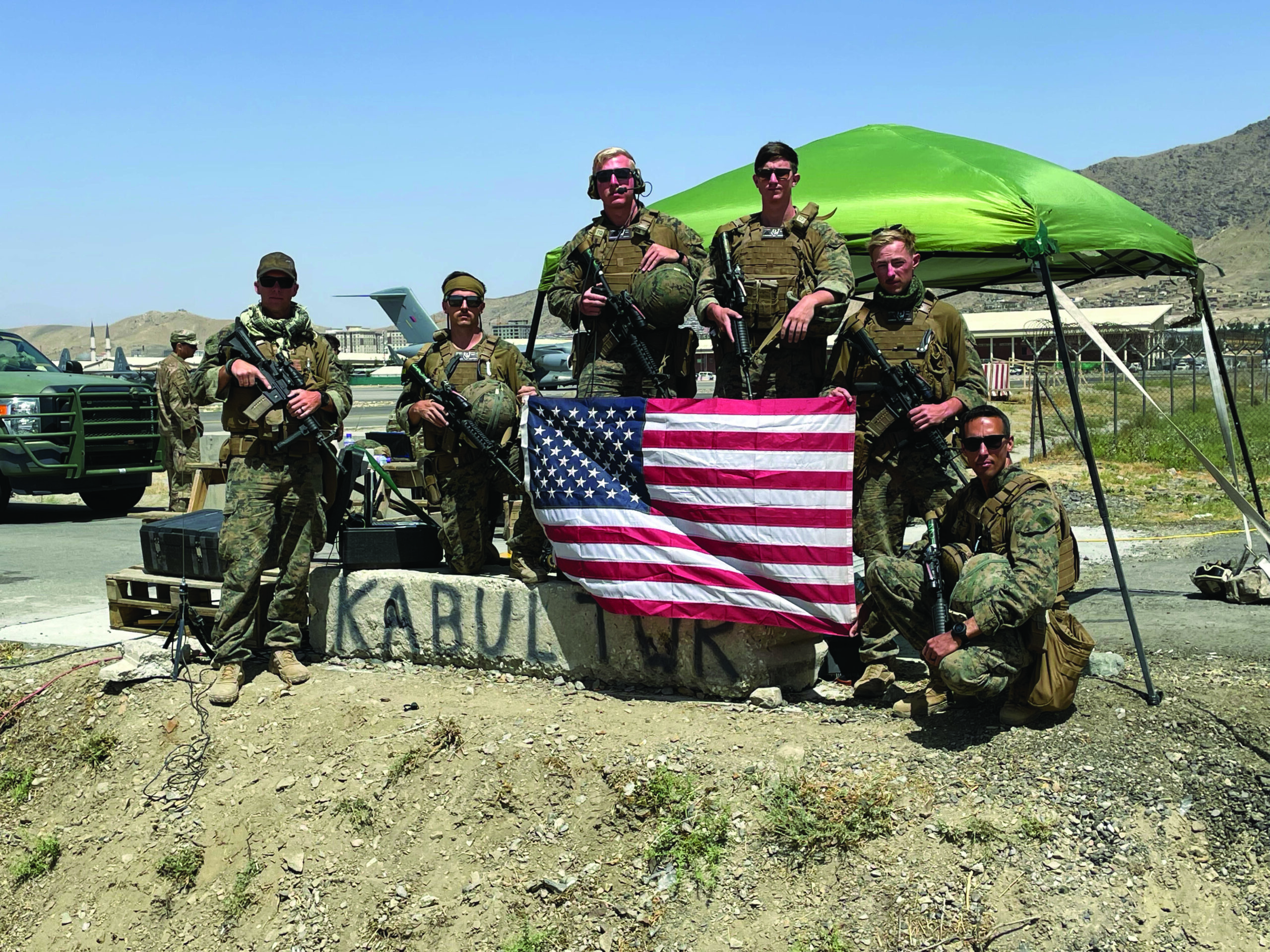
For their outstanding performance in the evacuation, Haunschild and JoseMendez both received a Bronze Star. Chryst received a Navy and Marine Corps Achievement Medal. The MMT’s experience in Kabul serves today as the most recent major example of the type of situation Marines can encounter at any time.
“God forbid another MMT finds themself in this kind of situation where everything is unknown,” Haunschild reflected. “You run out of food. You run out of water. You run out of resources. Your logistics chain is cut off. You land, you walk out, and you don’t know if you’re going to leave. This is why we train, this is why we consider ourselves consummate professionals within our MOS, so we can do it anywhere.”
For now, MMTs offer the primary source of deployment with each MEU. The expeditionary capability that Air Traffic Control Companies provide will no doubt be called into action in the event of a major conflict. New gear has been distributed to the companies to upgrade their capability in austere environments and more thoroughly integrate their data into the overall aviation command and control systems. The MMTs deploying with MEUs, or ahead of airfields in a combat zone, will also see changes in the near future.
“Our current organization limits the ATCs within a MMT from providing the full capability of what those Marines are trained to provide,” said Kiley. “We are currently rewriting our Marine Corps Task to unchain our folks and acquire the equipment that allows them to be much more capable, similar to the actions that occurred in Kabul. What those Marines did was herculean. They acquired equipment and gear and did things well beyond the scope of an MMT. The future MMT will be a robust C3 node. They will be able to disaggregate into multiple teams to support multiple sites.”
The necessity for the all-weather capabilities Marine ATCs offer will only be magnified in the next war. As they stand poised to provide this critical enabling function for Marine aviation in combat, the future for these Marines looks dynamic and active.
Author’s bio: Kyle Watts is the staff writer for Leatherneck. He served on active duty in the Marine Corps as a communications officer from 2009-2013. He is the 2019 winner of the Colonel Robert Debs Heinl Jr. Award for Marine Corps History. He lives in Richmond, Va., with his wife and three children.




